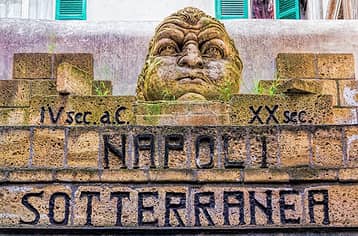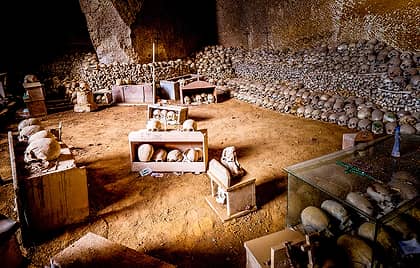Naples Underground


Naples Underground (Napoli Sotterranea) is one of the most popular attractions in Italy’s southern city of Naples. This underground route that includes everything from ancient Roman ruins and aqueducts to caverns used as bomb shelters during World War II provides a fascinating glimpse into the history of Naples that is compelling for both adults and younger travelers. Private tours of Naples Underground and underground tours in languages other than English and Italian can also be booked.
Starting point: Piazza San Gaetano 68 (historic center of Naples, on Via dei Tribunali).
Opening hours: Open daily, guided tours only. Tours depart every hour from 10 AM to 6 PM, in Italian and English.
Duration: 90 minutes.
Price: €15 for adults. Reduced ticket available up to age 17.
We recommend booking tickets in advance, especially on weekends, during Christmas, and in the summer. Tickets can also be purchased on-site, but wait times may range from 10 to 90 minutes during peak periods.
For groups of more than 10 people, reservations are required.
Private tours and tours in other languages are available on request.
Easy route, suitable for most visitors—except those with reduced mobility.
Book online Naples Underground
Reviews at a glance
Pros
Knowledgeable and passionate guides, often praised for clear explanations.
Fascinating historical content spanning Greek, Roman, medieval, and WWII periods.
Well-organized tours, even when groups are large.
Atmospheric and mysterious environment, with dim lighting and narrow tunnels.
Balanced tour length (around 90 minutes), not too short nor too tiring.
Central location easily accessible from major tourist streets.
Reasonable ticket price, considered good value for money.
Good mix of facts and storytelling, appreciated by both history lovers and casual visitors.
Easy to find entrance near Piazza San Gaetano.
Family-friendly experience, educational for both adults and older children.
Cons
Very narrow passages, uncomfortable for people with claustrophobia.
Language mismatch issues, especially when English tours were unavailable.
Large group sizes, which can affect audibility and interaction with the guide.
Strict scheduling, limited flexibility for latecomers.
Lack of informational signage, everything depends on the guide.
Not wheelchair accessible, difficult terrain for people with limited mobility.
Not ideal for toddlers, due to stairs, darkness, and length.
Naples Underground, in a shortcut
The ancient Greeks built much of their city here on the Bay of Naples with tuff stone that they extracted from underground, leaving behind caverns and tunnels. The Agorà (main square) once sat where the Basilica di San Lorenzo is now located.
The Romans expanded the city, adding a sewer system and underground aqueduct that transported water from springs near Serino to the city center.
During the Bourbon reign, Naples' ancient Roman aqueduct was expanded and the city became one of the first in Europe to provide potable water to residents' homes.
The underground tunnels and caverns dug out over the millennia were used as bomb shelters during WWII, and Neapolitans would head beneath the city to take cover during raids.
Today, in addition to being a popular tourist attraction, the Napoli Sotterranea site houses a number of scientific experiments, including underground gardens and seismic instruments to monitor any activity on Mt. Vesuvius.
Napoli Sotterranea - The Underground Tour from Via dei Tribunali
Napoli Sotterranea - The Underground Tour from Via dei Tribunali
The Napoli Sotterranea (Underground Naples) guided tour begins at street level in Piazza San Gaetano, a cross street of Via dei Tribunali, in the heart of Naples' historic center (once known as Neapolis). At the entrance, there are 136 low and easy-to-navigate steps that take you 40 meters below the modern city. Here, you can admire caverns carved into the soft tuff stone in the fourth century and first used as cisterns for water; in the mid-20th century, these same rooms protected locals as air-raid shelters. The Roman-era cisterns used for water supply are still visible and remarkably well preserved. Some WWII shelters still display wall inscriptions and original furnishings left by those who took refuge underground.
The tour then passes the earthquake monitoring station to visit a number of ancient ruins, including burial catacombs.
The walking tour takes about an hour to complete and the spaces are all quite large. The tour passes through damp, dimly lit spaces and narrow tunnels that create a haunting and immersive atmosphere. There is one tight passage of underground tunnels that is about 10 meters in length, is lit only by candles, and leads to a cistern (once part of the Roman aqueduct system); visiting this portion of the route is optional and those who would rather avoid this enclosed space can sit it out on a nearby bench.
After the initial section, the tour continues with a visit to an ancient Greek-Roman theater. The Greco-Roman theater is accessed through a “secret hatch” hidden beneath the bed of a ground-floor apartment (traditional Neapolitan “basso” apartments) and is the remains of a performance space in the ancient city dating from Emperor Nero, as well as a number of canals dating from the time of the Bourbon reign and decorated with delightful majolica ceramics.
At the end of the tour, you can stop at the War Museum (Museo della Guerra) to admire documents and other artifacts from the Second World War.
You are welcome to take photos and videos during the tour.
Getting to Napoli Sotterranea
Getting to Napoli Sotterranea
The Napoli Sotterranea tour beginning point - Piazza San Gaetano 68 - is located on Via dei Tribunali in the historic center of the city where vehicular traffic is limited, so can only be reached on foot. The nearest metro station is "Dante station" one line 1 (direction Piscinola).
If you are arriving by car, park at the Duomo, Piazza Cavour, or Corso Umberto parking garages, which are all about a 10-minute walk from the entrance of Napoli Sotterranea.
Tips for Visiting Napoli Sotterranea
Tips for Visiting Napoli Sotterranea
The route is not challenging and anyone can visit. If you are traveling with young children, opt for a baby carrier or backpack rather than a stroller as there are a number of steps; there is a baby stroller (pushchair) parking area at the entrance. In general, the tour is not well suited for children aged 2–3.
The steps are wide, have a handrail, and are easy to navigate even for those who have to be cautious about stairs.
The underground spaces are all quite large and are suitable even for visitors who suffer from claustrophobia. Visitors can decide to leave the tour at any point and return to ground level if they decide that they are not comfortable remaining underground.
The temperatures inside Naples Underground remain quite cool all year round, so bring a light jacket or sweater
Groups can be large, making it hard to hear the guide; early-morning or late-afternoon tours are the least crowded.
There are no restrooms along the route—use them beforehand.
Arrive a little early for your scheduled tour so you don’t miss your reserved time slot.
Restaurants near Naples Underground
Restaurants near Naples Underground

Naples Underground is located in the heart of the old town and there are endless options for dining nearby. The most famous pizzerias in the city are just steps away, including names like Sorbillo and Di Matteo. Keep in mind that there are often long lines at these popular spots to get a table. Even if you don’t want to wait in line at one of the A-list pizza restaurants, you can opt for any pizzeria in the area and have a great pie. If you’d rather try traditional Neapolitan specialties like pasta and main courses, try Da Carmine and Campagnola or il Leon d'Oro in Piazza Dante. For a satisfying bite on the go, stop at one of the many street food stands and order a "cuoppo" (paper cone of deep-fried seafood) or other snack to nibble while you explore.
Street Food in Naples
If you enjoyed Naples Underground and would like to visit something similar, explore the Bourbon Tunnel, the Catacombs of San Gennaro, and the Catacombs of San Gaudioso. This is another “Naples Underground” attraction that begins beneath Piazza Trieste e Trento, next to Piazza Plebiscito and opposite the Royal Palace. Of course, you can also visit the ruins of Pompeii.
Other Underground Sites in Naples
Other Underground Sites in Naples
La Napoli Sotterranea
This underground site, which (somewhat confusingly), shares the same name as the main Naples Underground discussed above, begins from Piazza Trieste e Trento next to the central Piazza Plebiscito and just opposite the Royal Palace. The route snakes its way through a warren of tunnels directly beneath the heart of the centro storico, the Quartieri Spagnoli. The site is appropriate for all visitors.
The Bourbon Gallery (Galleria Borbonica)

This underground site was excavated by Frederick II of Bourbon and stretches from the Royal Palace to Piazza Vittoria near the seafront; it was constructed to provide the royal family an escape route in case of an uprising. There are a number of visitor routes to choose from, from the classic option that includes a stretch on a charming raft to the more adventurous option that includes a spelunking portion. There are different entrances depending on the route you choose: the Domenico Morelli parking area, Via Monte di Dio, or Vico del Grottone near Piazza Plebiscito.
Tickets for the Bourbon Gallery (Galleria Borbonica)
La Neapolis Sotterranea
Beneath the spectacular Basilica of San Lorenzo and just steps from San Gregorio Armeno hide remains of the Greek and Roman city of Neapolis, the first inhabited settlement that grew to become present-day Naples. Venture underground to walk along an ancient road lined with the remains of shops like a bakery and butcher. The entrance is located in Piazza San Gaetano 316, a few steps from the classic route above.
Visit the Complex of San Lorenzo Maggiore
The Catacombs of San Gennaro
Set in the Capodimonte neighborhood, these catacombs are named after the patron saint San Gennaro, who was buried here until his remains were moved to the city's cathedral.
Visit the Catacombs of San Gennaro
The Catacombs of San Gaudioso
In the Sanità district, the underground areas beneath the Church of Santa Maria della Sanità house the remains of thousands of deceased Neapolitans.
Visit the Catacombs of San Gaudioso
The Church and Museum of Santa Maria delle Anime del Purgatorio ad Arco:
You will immediately spot this church set along Via dei Tribunali by the skulls decorating the entrance. This was once the most important hub of the Neapolitan tradition of "anime pezzentelle", or souls trapped in Purgatory who needed prayers from the living to release them into paradise. You can see the skull of "Lucia", covered in a bridal veil and decorated with flowers; according to legend, she died shortly before her wedding day.
The official Santa Maria delle Anime del Purgatorio ad Arco website
The Fontanelle Cemetery

One of the most recent catacombs this burial site was founded in the 16th century as a mass grave for victims of the plague and became used as a paupers' grave over the following centuries. Today it holds almost 40,000 skulls.
The official Fontanelle Cemetery website
The Pausylipon and Seiano Grotto Archaeological Site

This ancient site in the Posillipo neighborhood contains a number of Roman ruins, including a theater and aqueduct. Visitors can access the site by passing through the Grotta di Seiano, a network of underground tunnels that were once used as part of the city's drainage system. The site is particularly spectacular due to the views over the Bay of Trentaremi and is a fascinating off-the-beaten-path site far from the tourist crowds.
The official archaeological park website (Italian only)
FAQ - Frequently asked questions
How many different Naples Underground routes are there?
There are a number of underground routes in Naples that include tunnels, galleries, catacombs, and burial grounds. The most important is the Naples Underground cobered above, which begins near Via dei Tribunali. The second, known as "La Napoli Sotteranea", begins on Vico Sant'Anna near Piazza Trieste e Trento.
Another interesting underground site is the Bourbon Tunnel (also known as the Bourbon Gallery), which has three entrances: Vico del Grottone (in Piazza Plebiscito), Via Monte di Dio, and near the D. Morelli parking area. There are a number of different routes inside the tunnel, from classic walking tours to speleological excursions for the more adventurous visitor.
Can I visit Naples Underground if I’m claustrophobic?
For the tour that begins from Piazza San Gaetano, there is only one portion of the route that is very tight and visitors can sit that portion out in a more spacious cavern. That said, the entire site is underground so can be a challenge despite the wide tunnels and chambers.
Do I need to book tickets to Naples Underground in advance?
Yes, Naples Underground is one of the most popular attractions in Naples and visitor numbers are limited each day, so it’s a good idea to book your ticket in advance so you can ensure your spot for a tour at the time and in the language you prefer.
Book your Naples Underground ticket in advance
Are the groups very large during the tour?
During peak seasons and weekends, groups can be quite large. While the tour is well managed, the number of participants may make it harder to hear the guide in tight spaces. Booking an early time slot may help reduce crowding.
Are there restrooms on site?
No restrooms are available inside the underground tour path. It’s advisable to use nearby facilities before entering, especially since the tour lasts over an hour.
Can I visit Naples Underground without a guided tour?
No, visits are only possible with a guided tour. The underground area is not open for self-guided exploration. Tours last approximately 90 minutes and provide historical context, safety guidance, and access to otherwise restricted areas.
Are tours available in English?
English tours are offered, but availability may vary depending on staff and scheduling. Some visitors have reported joining Italian-only tours despite requesting English. It’s recommended to confirm language availability when booking.
How long is the tour and what does it include?
The standard tour lasts about 1.5 hours. It includes ancient Greek and Roman tunnels, cisterns, World War II air-raid shelters, and narrow staircases carved into the tuff stone. A separate visit to the remains of the Roman Theater is also available, accessible from a nearby entrance.
Will there be waiting times during the tour?
Typically, the tour moves continuously, but short pauses can occur when multiple groups pass through the same area. These are usually brief and not disruptive.
Do I need to book in advance?
Booking is not mandatory but highly recommended, especially on weekends and during peak periods. Capacity is limited, and wait times at the entrance may exceed one hour.
Is it accessible for people with mobility issues?
The site is not recommended for visitors with reduced mobility. The tour includes narrow tunnels, steep staircases, and uneven surfaces that may be difficult to navigate.
What makes this site different from other underground attractions in Naples?
Naples Underground focuses on a historical mix of Greek, Roman, and World War II structures in one continuous tour. Unlike catacombs or the Bourbon Tunnel, it offers a more comprehensive overview of the city’s layered underground history. It is also easy to walk through and suitable for everyone.
How deep is Naples Underground and how extensive is the site?
The tunnels lie about 40 meters below street level and stretch over a wide area beneath the city center. Some parts extend under churches, homes, and historic buildings, showing how the city evolved above ancient foundations.
Is the experience child-friendly?
It depends on the age. Older children often enjoy the experience, but toddlers might struggle with the dark areas, stairs, and long explanations. Parents should evaluate based on their child’s comfort.
Should I arrive early even if I have a reservation?
Yes, it’s recommended to arrive at least 15 minutes early. Group entry is punctual and arriving late may result in missing your slot, especially on busy days.
Can I take photos during the tour?
Yes, photography is generally allowed, but without flash. Some sections may restrict filming depending on the guide’s instructions. Always follow the guide’s directions
Is the tour physically demanding?
The tour is not particularly strenuous for most people, but the heat, humidity, and enclosed spaces may be tiring, especially in the summer months. Comfortable shoes and light clothing are recommended.
Are the guides professionally trained?
Most reviews praise the guides for being informative, engaging, and enthusiastic. Their storytelling and deep knowledge are often cited as a highlight of the experience.
What do visitors find most surprising about the tour?
Many are surprised by the stark contrast between the lively city above and the silence below. The immersive feeling of walking through centuries of hidden history is frequently described as the most memorable aspect.